
Trust, bordering and necro-racism
Soundings 88 (2024)
How disenchantment with government has fuelled necropolitics; statue mania in the age of empire; and a conversation about censorship, self-censorship and Palestine.
The informal politics of distribution on the streets, of begging and of giving, makes visible the faults inherent in European welfare systems, writes Cecilia Parsberg. And the rules and statutes that aim to prevent poverty-stricken EU citizens from enjoying free movement add insult to injury.
In the summer of 2011 I hire a professional market researcher to conduct a qualitative market survey in which givers in Sweden share their views on those who beg on the streets and answer my question about how the latter could beg more successfully.1
The recruitment firm I hired was instructed to find twenty people who had given money to someone begging on the street at least once and who could see themselves doing so again.
For two hours eight people talk about their approach to people begging on the street. After that another group talks for two hours.
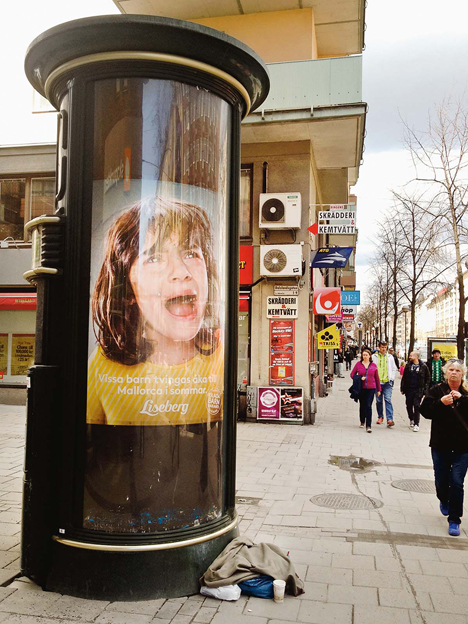
Eva, the market researcher, has them discuss pictures that show various positions, expressions and gestures that people who beg inhabit and perform to get money. I sit behind a two-way mirror in the room where these surveys are being conducted. I hear and see people express their feelings: aggression, guilt, shame, a desire to include and embrace, faith, hope, melancholia, deficiency, authoritarianism and powerlessness. Even if you do give, nobody gives to everybody and excuses must be fabricated to justify this. They all concern how to keep beggars at a distance. One strategy replaces another. High demands are placed on the beggar in terms of sensitivity to circumstances. The view of the beggars is that they must “earn their keep”. They must somehow deserve the money they get from the person giving it. Then the market researcher puts together a report. In it, it becomes evident that a successful beggar:
1. Is in a dire situation that is more or less temporary.
2. Is active – gets something because they are doing something.
3. Is relatively clean – nobody wants to be close to someone who is too dirty.
4. Is “normal” – a person with “normal” clothes that one can identify with is easy to understand – and does not make the giver uncomfortable with strange or unusual rituals.2
5. Can offer a reason for being in said situation, or explain what the money is going to be used for.
These answers disqualify many of those who beg on the streets of Sweden. It is clear that beggars, in various ways, need to live up to the demands of “authenticity” that we, the potential benefactors, make. Different types of beggars are ranked in relation to that ideal.
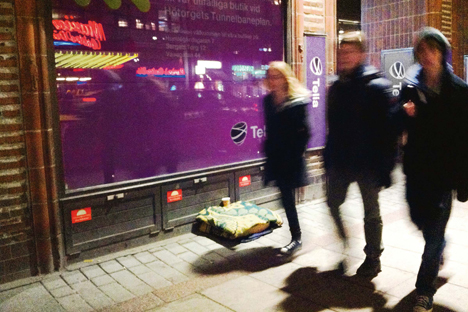
During the summer of 2013 I try, in a similar vein, to ask all of those begging on Götgatan in Stockholm, from Slussen to Skanstull – a stretch I walk daily – about their image of those who give on the streets. Laura Chifiriuc is my interpreter. She subtitled my film with EU-migrants begging in Gothenburg and is well versed in the lines of inquiry.3 She’s from Romania and while we can’t assume that those begging that day on the streets of Gothenburg speak Romanian, it turns out that everyone, except for one Swedish man, does. Which means that all but one are EU-migrants. Two of the people don’t want to speak to us. They raise their hand when they see my camera and even after Laura explains what we are doing they’re not interested. The rest tell of their situation.
We ask how business is going and what they do. They’ve come to Sweden to try to make money for their own survival and for that of their family. In different ways they explain that things are very hard in Romania. There is no work, no support, no nothing. Some of them have had their homes destroyed by flooding. When they arrive in Sweden they help each other with food, a place to sleep and travel. They want to be able to send money back home, but many of them feel that begging has become a lot harder – people give less and less – and many of them believe this is due to increased financial hardship for people in Sweden. None of those we speak with have any expectation of receiving aid from the Swedish welfare system.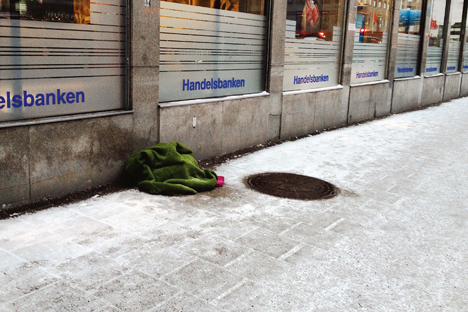
In August 2013 Laura and I travel to Bucharest to interview people begging there. Despite a Romanian law prohibiting those who are deemed able to work from begging, Laura has seen people do it during the winter of 2012.4 For three days and nights we look, in the same kinds of places where you would normally find people begging in Sweden: in the subway, outside shopping malls, places with a high volume of pedestrians. The first day we find two retirees begging to supplement their pensions. The street is also a way for them to meet people. First we meet an older man, on sick leave since 1989, whose pension does not cover his rent. Around the corner we find an 80-year-old woman who tells us that her husband recently died. That the funeral was so expensive that she ran out of money. She’s there temporarily, for a week, waiting for her retirement check that has been delayed due to a public holiday. She doesn’t ask anybody for money; but people still give and many seem to know her. We move on to Calea Victoriei. On the sidewalk, across from the police headquarters a man sits begging. One of his legs has been amputated.
For me this is the only way to survive, but I dream of a real job. I still have both my arms. I’ve heard from friends that it is possible for cripples to get upper-body work and I would love that opportunity, but nothing seems to happen. Perhaps I should try to get to a different country.
He says he has been begging on the street for 18 years, since the accident, and that the police let him be since he isn’t considered able-bodied.
Then we go to the old city, the quarters tourists visit to shop and eat at sidewalk cafes. Surely there will be beggars there. But we don’t find anyone. We ask some patrolling policemen and they say that some who used to beg now sell roses, safety pins and other things, the rest aren’t here anymore. Those who can’t survive in Bucharest seem to go to other European cities. Free movement within the EU has created an opportunity for people to seek sustenance in other parts of Europe. Laura’s Romanian friends joke that “we export beggars”. They don’t look happy when they say it.
The number of poor EU migrants coming to Sweden for work is expected to rise significantly. Some of them build their own homes – often together – on commons, some rent a place to sleep, some sleep on the streets. Socialstyrelsen, the Swedish national board of health and welfare, found 370 homeless EU migrants in Sweden when they attempted to map homelessness among EU migrants, however the government coordinator for the homeless, Michael Anefur, estimates that the actual number is somewhere between 1,000 and 2,000 people.5
Aaron Israelsson, the editor in chief of Faktum magazine writes:
In 2013 alone Romania received 3.6 billion dollars from guest workers abroad. That amount includes large sums acquired through begging on the streets of Sweden, among other places. This aid is far more effective than the EU’s earmarked economic aid to the Roma minorities in the eastern member states. Because it turns out that the EU money has had virtually zero impact, according to the EU’s own accounting reports.6
If that is the case: then why is the “aid” given by the individual donor on the street to the person begging handled better than the official EU aid?
We didn’t find any Roma begging in Bucharest. The disabled man is not Romani, nor are the retirees or the young man we spoke to. Neither are they EU migrants. There are many life stories behind begging, but the fact is that most migrants begging in Europe are Roma. The majority of those I’ve spoken with in Gothenburg, as well as on the streets and in the various encampments in Stockholm, have been Roma. Those Roma who exploit the freedom of movement to find sustenance in other countries, when their own country doesn’t meet their needs, are trying to take their circumstances into their own hands and improve them. The fact that Roma emigrate in higher numbers also has to do with anti-Gypsyism: the historic and continued racism directed at Roma.
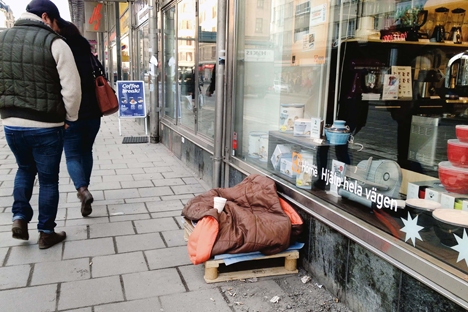
In February 2012, the European Council issued a report on traveller and Roma human rights in Europe. Thomas Hammarberg ordered and published the report in his capacity as commissioner of the European Council: “The commissioner has repeatedly highlighted that anti-Gypsyism is a crucial factor preventing the inclusion of Roma in society and that resolute action against it must therefore be central to any efforts to promote their integration.”7
On 20 March 2014, Hammarberg makes a statement on Sweden’s treatment of Roma EU migrants. “The municipalities are unwilling to do anything to indicate that they understand the situation, they won’t even install a toilet. Nor do they want to create more beds in homeless shelters. Nothing is done to improve daily life.”8 Responsibility is pushed upward and sideways when the Romanian ambassador proposes that Sweden needs to ban begging, as Romania would then care for its own. At the same time one points to the overly national EU policy and argues that the individual nation-state – in this case Romania – is responsible for using the EU aid it is given for Roma. They need to “pay their bill”, as some from the Swedish liberal party put it. “The government exploits EU cooperation to circumvent accusations that they are creating policy in nationalistic self interest.”9 The alternative appears to be further centralization of power.
On 25 March the Swedish government presented a white paper on abuse and violations of Roma.10 It is called “The dark and unknown history”. The same day that the report was issued, Socialstyrelsen issued a press release in which they accept historic responsibility: “Socialstyrelsen and medicinalstyrelsen [the national board for medicine] have repeatedly been more than passive executors, they have been active in discriminating against Roma and travellers, or limiting their access to social support, says Eva Wallin.”11 Does this include present-day EU migrants?
The discourse on begging is associated with, but should not be confused with, the Roma situation. The Schengen Agreement (Romania is not yet a member of Schengen, but is expected to become one according to the Swedish government’s informational homepage about the EU)12 was updated in June 2013 regarding interaction between member states. “The new rules for evaluation mean a transition from the current inter-state system for audit to an EU strategy in which the central coordinated role is given to the Commission.”13 What does this mean? To what extent can a country interfere with another country’s actions when this has consequences for other member states, for instance regarding reactions to begging? In which way are the Romanian and Swedish systems connected (if at all) because of the EU? Hans Swärd, professor of social work in Lund, answers my questions: “They are connected for certain groups who are in the labour market or the educational systems. There are rules regarding the right to study in other EU countries and, if you work in another EU country, there are a number of agreements. The problem is that the system does not include those outside of the labour market.”
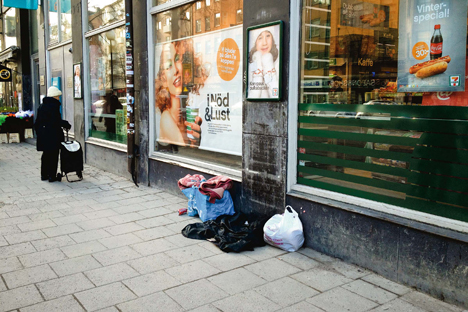
The question of the situation of poor EU migrants has reached a point where it has begun to generate resistance from other parts of society. During a few winter months in 2013 and 2014, a group of activists at the Cyklopen cultural centre in Högdalen, Stockholm, demonstrate through action that they see and hear the predicament of the beggars. They organize clothing drives and actions. The organizer is invited to sit on the couch at Gomorron Sverige, a morning news show on national Swedish TV.
“Why are you doing this?” the host asks Anna Silver, who started the Facebook group14 and organized the drives. “It could have been me”, she says. With that the discussion about solidarity across national borders is underway. She doesn’t speak for them. She isn’t claiming to give them a voice. She sees them and she sees herself in them, sees all of us, enmeshed in various cultural and social structures and conditions.
“The mechanical solidarity that has its roots in highly homogenous societies, presupposes sameness between people; similarity creates cohesion. Organic solidarity, a more solid unit, conversely, is built on difference”, writes Sven-Eric Liedman, professor of history of ideas.15
The registry that the police has been criticized for – there is an ongoing investigation into whether it was an ethnic registry of Roma or not – has, by dint of the subsequent debates contributed to revealing the image of Roma held by an institution of power serving national justice. Protests are staged by groups such as Cyklopen, Aktion Kåkstad, Allt åt Alla, Det Kunde Varit Jag, Ingen Människa är Illegal, Insamling för Hemlösa EU Migranter i Högdalen, Linje 19, Solidaritet för 17, Vänsterpartiet Sollentuna and others. On 13 March 2014 job-seeking and homeless EU migrants were ousted from their camp on abandoned military area in Helenelund, in Sollentuna. The camp was later demolished by bulldozers.16 When the authorities handle statutes and rules there is always room for interpretation. In its report, Socialstyrelsen calls for more knowledge on what the praxis is for these migrants, for the social services in the various municipalities and for the volunteer organizations.
“Many don’t know the rules. […] One wishes that everyone would see the possibilities rather than the restrictions in the statutes.”17
The application and interpretation that the authorities used in this instance was not in line with the EU Commission’s recommendation of a change in attitude aimed at counteracting discrimination against Roma. Activists in the action groups interpreted the legislation differently. On the Facebook page “Stoppa Vräkningen i Helenelund” [Stop the evictions in Helenelund] they describe the course of events thus:
– The eviction notice that says that everyone living in the area has to leave came two days beforehand.
– Authorities used English to inform those living in Helenelund about the eviction, a language the latter do not understand.
– The actual eviction notice was signed by the city of Stockholm, which is incorrect as this is the municipality of Sollentuna.
– There are several different deadlines for appeal. Ten days as well as three weeks.
– In the eviction notice it said that the camp was located in a recreational area, which is completely wrong, it is an abandoned military area.
– Forty-five names were listed, but twice as many people lived in the camp. And one cannot evict people if one does not have their identity numbers.
– One of the reasons for the eviction is littering, which is also not correct as the place is tidy, seeing that those living there are responsible for cleaning up all garbage.
Commissioner Thomas Hammarberg again: “If we handle this well and show at least a modicum of dignity when we approach those who come here and don’t send people away, but instead actively contribute to change in their home countries, this could be remembered as a period in history during which people were proactive and didn’t merely sweep Roma human rights under the rug.”18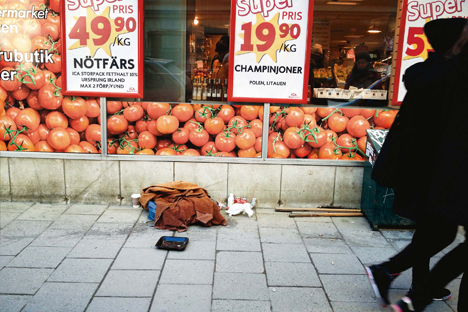
Free movement is intended to open up national borders, but when poor EU citizens make use of this freedom to travel and do what they can to make money within the framework of the law, they are met by rules and statutes that aim to prevent them from enjoying this possibility. The press release for the previously mentioned report from Socialstyrelsen says: “The fundamental rule in the EU legislation for freedom of movement is that job-seeking EU migrants have the right to avail themselves of social services in the EU country and in the municipality in which they are present.”19 However, Socialstyrelsen has found, in its investigation, that “In Swedish municipalities the social services usually make the assessment that EU migrants20 only have the right to aid in emergencies and in those instances usually in the form of contributions toward a ticket home and emergency housing in connection to this. EU migrants are included in the ‘roof above ones head’ guarantee in those municipalities in which such a guarantee exists.”21 According to the supra-national ordinance adopted by the European Parliament and the EU Council, equal treatment is to be guaranteed and include all persons within the territory of a member state, but the individual states act differently.
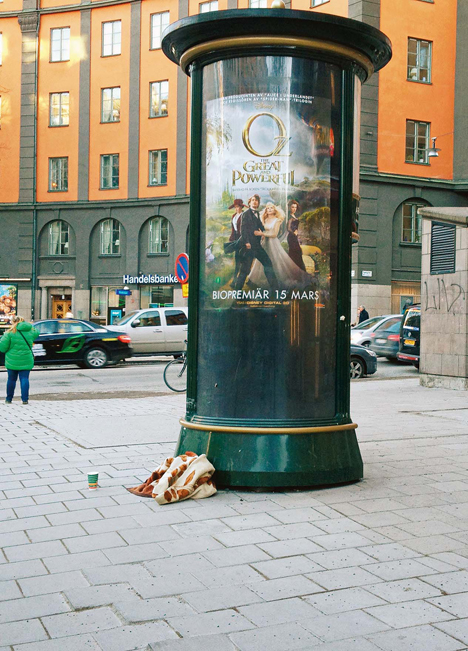
On the Swedish government’s informational homepage about the EU you can read: “For the freedom of movement to work in practice the EU nations have drawn up a system for coordination of social security benefits within the EU. […] The rules for coordination mean that for instance a person who moves to a different EU nation to work, should, in principle, be covered by the host country’s social security system from the first day of work.”22 That this regards “work” is clear. However, what seems unclear is which rules of coordination apply to those seeking work: “Socialstyrelsen’s assessment is that municipalities and authorities that encounter the EU migrants are in strong need of understanding relevant rules and how they should be applied. This regards for example when a person is registered with the unemployment office, or evaluated for assistance or temporary housing.”23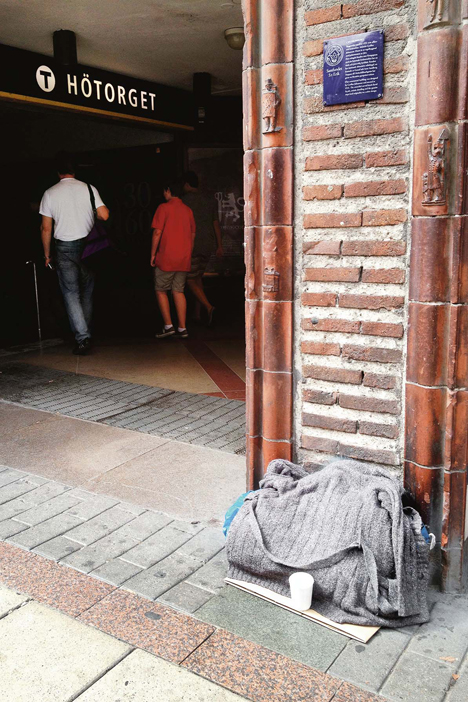
How does the national system for human rights and solidaric welfare work in the context of the supra-national system built on the basis of consensus within the EU? I pose this question to Hans Swärd over email and he answers:
It is only recently that the EU has been able to agree on joint poverty programs. Often the goals are long range and have been difficult to reach. There are big differences between the poorest and the richest EU nations. To access the welfare systems in the various countries one needs to have a permanent residency permit, have worked and qualified for sick leave, pension etc. The very poorest groups end up outside of the traditional safety nets.
For the poor, freedom of movement is limited, both within national and supra-national law and justice, and if you are Romani the risk is even bigger that you also are subject to ethnic discrimination.
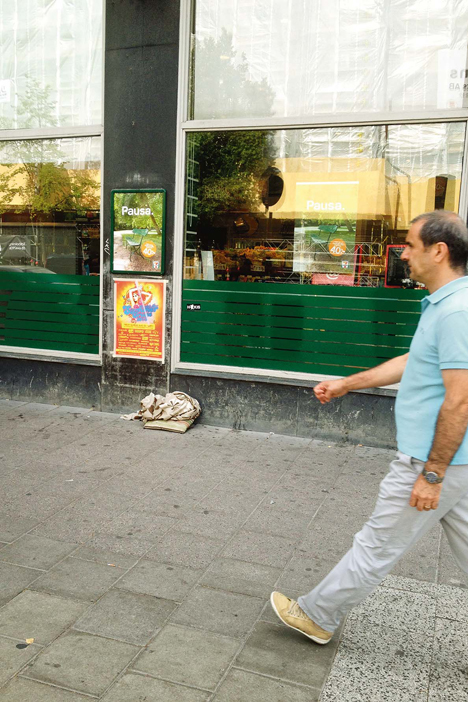
Peo Hansen, a political scientist, studies migration politics and integration in Europe. He maintains that few political topics give a clearer picture of the issues central to the construction of civil society. Migration policy functions as a lens through which we see what the EU wants to be and what it wants to become. He poses the question: Who belongs in the EU and who are the strangers; who is said to contribute to the construction of the new Europe and what is seen as a threat to it?”24 When this new edifice pushes people to their knees, in supplicant positions, on the streets of Europe and Europe does not assume responsibility for this, the European community one speaks of falters – to whom does it fall to uphold this community? Of what should it consist?
The charity of the individual toward the person begging cannot be the solution. “Solidarity!” the protestors shouted on 13 March 2014, before the demolition of the homes that seventy EU migrants had built in Helenelund, Sollentuna. Sven-Eric Liedman describes the difference between charity and solidarity thus: “Charity is based on one individual’s dependency on another; solidarity is based on a mutual dependency within the generally ruling welfare system.”25 Liedman argues that it is important to differentiate between a solidarity founded on mutuality and one that mainly, or only, is directed at those who are struggling. “As soon as the boundary between solidarity and charity is exploded, the solidarity directed at those in need will be emphasized.”26

Should the Swedish welfare system be based on solidarity or charity? The operations, other than social services, that contribute to caring for the poor and homeless in Sweden, are mainly churches, deaconry, the Salvation Army and the City Mission. What happens if the empathetic aspect of the political system is replaced by charity organizations and individual encounters on the street where each and every one is the judge of who is deserving and who is not? The Victorian adage concerning “the deserving and the undeserving poor”27 comes into play once again. Should it all hinge on whether or not I feel generous that day? When I want to give to the poor and when I want to abstain? That I devise strategies for whom I should give to and who is less deserving of a donation?
It is difficult to parse what affects attitudes to the poor on the street; if it is structural oppression that creates the attitudes, or if the attitudes create structural oppression. When I catch myself creating strategies for who I want to give a penny on the street – to that particular woman with beautiful eyes, or the man who always seems to have a slight smile on his face, but not to the one with tremors and a cane – I know I am caught in economically selective thinking and, yet these thoughts create a sort of space of action between me and the other, a space in which to articulate a policy built on other basic conditions. It is a demanding space, established on both an inter-human and a societal level.
In the market survey where those who give got to share their view of those who beg, as in my interviews with the latter in Sweden and in Romania, a multitude of images emerge that are at play in every encounter between the two groups on the street. Images of the nation’s (functional and dysfunctional respectively) welfare systems, the European Union’s (free and unfree) movement, complicity, racism, generosity, egotism, solidarity. Visions of what labour is and could be. Images of Roma. Of givers. To whom is the beggar really directing their plea?
The begging on the streets challenges the reigning EU policy, it raises questions about how the distribution should happen.
The giving on the streets challenges the same policy and raises the same necessary issues.
All photos by Cecilia Parsberg.
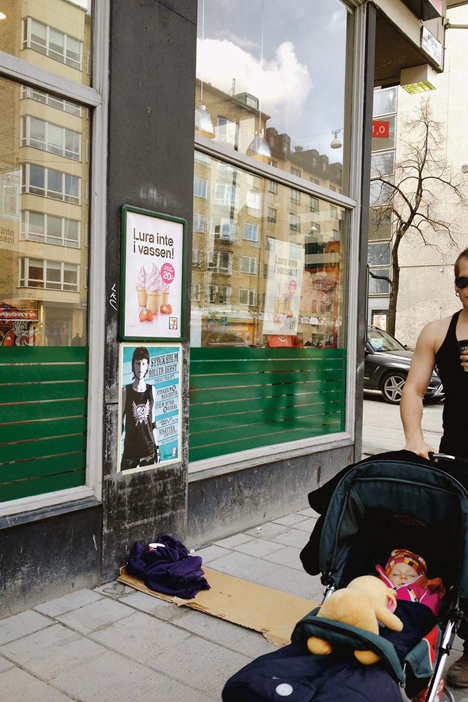
vimeo.com/66966202. Beggars share their views on givers in Sweden. In 2012, I interviewed 12 beggars who share their view on givers in Sweden. Each person was interviewed for 30 minutes in a film studio with an interpreter. They have been given fictive names in the movie. All participants were paid. This film is part of the project, "How do you become a successful beggar in Sweden?" See also tiggerisomyrke.se/. The interviews are screened in a video installation using two screens -- the other screen shows the interviews of givers in Sweden (the market survey). The installation has been shown at the Örekom festival in Lund/Roskilde and at the Museum of World Cultures in Gothenburg. It will be shown as part of the dissertation project: "How do you become a successful beggar in Sweden?"
Statute 61 from 1991 prohibits a person able to work from appealing to the public for charity. politiaproximitate.ro/legea_61.html.
According to Michael Anefur (KD), national homelessness coordinator, there are at present no numbers on the amount of beggars. Many estimate it to somewhere between 1,000 and 2,000 people, but nobody knows for sure. Most agree that they are very few, but very visible. See: www.dn.se/ekonomi/svenskarna-for-tiggeriforbud/.
"Human rights of Roma and travellers in Europe", Council of Europe Publishing, 2012, 40, www.coe.int/t/commissioner/source/prems/prems79611_GBR_CouvHumanRightsOfRoma_WEB.pdf
Peo Hansen, EU:s migrationspolitik under 50 år: ett integrerat perspektiv på en motsägelsefull utveckling, Studentlitteratur, 2008, 218
"The new evaluation rules mean a shift from the current intergovernmental system of peer review to an EU-based approach where the central coordinating role is given to the Commission." See: "New Schengen rules to better protect citizens' free movement, European Commission, MEMO/13/536", europa.eu/rapid/press-release_MEMO-13-536_en.htm.
After the camp in Högdalen was demolished by authorities on 13 March 2013, the EU migrants went to Sollentuna to build a new camp. See: "Insamling för hemlösa EU-migranter i Sollentuna", www.facebook.com/hogdalenmisar.
Sven-Eric Liedman, Att se sig själv i andra, om solidaritet, Albert Bonniers, 2012, 27
"Stoppa vräkningen av EU-migranterna i Helenelund", www.facebook.com/events/679334188789448
"Hemlöshet bland utrikesfödda personer utan permanent uppehållstillstånd i Sverige", 34, www.socialstyrelsen.se/publikationer2013/2013-5-3
"The term EU migrants denotes: EU/EES citizens, people who come from a country outside of the EU, but have been living in the EU for more than five years, as well as foreign-born individuals who are not in the process of applying for asylum." www.socialstyrelsen.se/nyheter/2013maj/.
"Hemlöshet bland utrikesfödda personer utan permanent uppehållstillstånd i Sverige", 31, www.socialstyrelsen.se/publikationer2013/2013-5-3
"Samordning av socialförsäkringsförmåner inom EU", eu-upplysningen.se/Om-EU/Vad-EU-gor/Schengen-och-fri-rorlighet-for-personer/
Peo Hansen, EU:s migrationspolitik under 50 år: ett integrerat perspektiv på en motsägelsefull utveckling, Studentlitteratur, 2008, 218
Sven-Eric Liedman, Att se sig själv i andra, om solidaritet, Albert Bonniers, 2012, 25
Ibid., 28
In the market survey it becomes clear that the beggars must be "deserving poor" in order for the givers to hand them money and that the begging is a temporary, dire situation.
Published 6 August 2014
Original in Swedish
Translated by
Sarah Clyne Sundberg
First published by Glänta 1/2014 (Swedish version); Eurozine (English version)
Contributed by Glänta © Cecilia Parsberg / Eurozine
PDF/PRINTSubscribe to know what’s worth thinking about.

How disenchantment with government has fuelled necropolitics; statue mania in the age of empire; and a conversation about censorship, self-censorship and Palestine.

From getaway destination to point of entry, the EU’s southernmost territories attract plenty of ongoing arrivals. Migrant containment policies, outlining stringent confinement and processing, would see newcomers restricted to the archipelago. But could Spain’s swift transfers and regularization turn the tide of migration strategy?